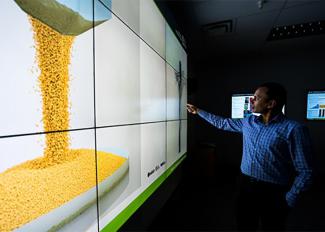NETL experts in systems engineering and analysis (SEA) are developing multi-scale approaches to modeling and analysis of technology, processes and markets. In 2020, through models and digital tools, reports and collaborations, the Lab’s SEA researchers made significant progress toward advancing technology solutions for our nation’s energy challenges.
One award-winning example of the solutions resulting from NETL’s SEA research is NETL’s Institute for the Design of Advanced Energy Systems (IDAES), a center of excellence for the identification, synthesis, optimization and analysis of innovations to meet the nation’s growing energy needs, which won a prestigious 2020 R&D 100 award, as one of the 100 most technologically significant products introduced into the marketplace in the previous year. Led by NETL’s Senior Fellow for Process Systems Engineering and Analysis, David Miller, IDAES is a collaboration with Sandia National Laboratories, Lawrence Berkeley National Laboratory, West Virginia University, Carnegie Mellon University and the University of Notre Dame. The IDAES Integrated Platform optimizes the design and operation of complex, interacting technologies and systems by providing rigorous modeling capabilities to increase efficiency, lower costs, increase revenue and improve sustainability.
Another innovative tool helping to enable affordable, abundant energy while protecting the environment is a new open-source computer model, developed through a collaboration among NETL, the U.S. Environmental Protection Agency and the National Renewable Energy Laboratory, that can quantify baseline life cycle impacts of U.S. electricity consumption, allowing for more robust and consistent analyses to inform decision-makers and stakeholders. Life cycle analysis examines the impacts associated with how purchased utility inputs can contribute significantly to the overall cradle-to-grave results for the system or product under evaluation, such as power plants and electricity use. There was no comprehensive, transparent, and bottom-up LCA model for electric power in the U.S. until the creation of this tool.
SEA work also supported better decision-making regarding the economic challenges of carbon capture, utilization and storage (CCUS), helping stakeholders to effectively evaluate the costs of implementing these technologies in electric power and industrial plants. To this end, researchers developed a first-of-its-kind suite of digital tools and resources that can effectively evaluate CCUS costs during each step of the value chain. The flexible design of the suite allows users to customize analyses as technologies advance, policies change or new policies are enacted.
The discovery, design and operation of energy systems benefits from systematic decision-making techniques for the often competing goals of maximizing profits, minimizing costs, addressing market and policy drivers, and meeting environmental and technical constraints. For example, SEA researchers published a paper that outlined process control models and operating strategies for the new Supercritical Transformational Electric Power (STEP) pilot plant, which is scheduled to open in 2021 on the Southwest Research Institute campus in San Antonio, Texas.
NETL also published several important reports in 2020 thanks to the work of SEA researchers.
- A report and case study released in February, Volume II of NETL’s “Reliability, Resilience and the Oncoming Wave of Retiring Baseload Units,” showed that additional natural gas pipeline capacity and baseload generation units — such as coal and nuclear generation — are critical to providing reliable and affordable electricity during extreme weather events.
- A study published in June demonstrated that under certain scenarios grid operators in the Electric Reliability Council of Texas would have possibly been forced to utilize extraordinary measures to ensure the operation of the Texas power system over the summer, including potential brownouts and load shedding.
- Another report released in June detailed adjacent market opportunities for high-performance alloy (HPA) research. HPAs are metals that display superior characteristics in high temperature and corrosive environments, and according to the report, the global HPA market generated more than $4 billion revenue in 2016, which is expected to climb to $7.6 billion in 2023.
SEA work underpins many of the Lab’s successes, including valuable partnerships like the NETL-City of Pittsburgh Memorandum of Understanding (MOU). The MOU was launched in 2015 to transform the city’s energy system and aging infrastructure. It provides an opportunity for NETL to demonstrate how fossil energy is a part of the clean energy future and to show how technologies invented at NETL can support safe and efficient energy use. In September, representatives from the SEA and Strategic Partnerships directorates summarized the Lab’s resources and tool supporting the MOU during a virtual meeting with the City of Pittsburgh, University of Pittsburgh, Carnegie Mellon University, Duquesne Light Company, RAND Corporation and other stakeholders.
In another collaboration, SEA work enabled the development of a new model for sustainable freshwater used by power plants. The model developed by Argonne National Lab (ANL) and NETL, with support from DOE’s Office of Fossil Energy (FE), will help communities balance the demands for water use among the power, agricultural, industrial, and residential sectors.
The Lab also collaborated with Our Nation’s Energy Future, a coalition of 26 natural gas companies, to calculate the greenhouse gas emission profile and methane emission rates across the group’s complete natural gas value chain.
These accomplishments are just a glimpse into the Lab’s SEA work to provide insights to new technology, identify new energy concepts and analyze energy system interactions to help solve the nation’s toughest energy challenges.




